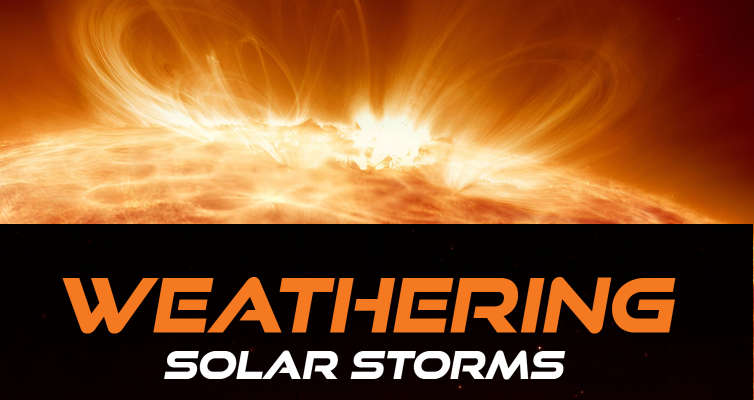Entering the peak year of the current Solar Cycle, GNSS users are already experiencing negative effects. The good news is that there are planning resources, and many of today’s advanced rovers can ride out all but the roughest solar storms.
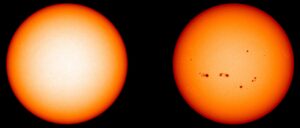
Comparison of sunspot activity during Solar Minimum (left) and Solar Maximum (right) – Credit: NASA
We are experiencing the peak of Solar Cycle 25 (the 25th since solar cycles were first recorded). The rocky times are expected to extend through 2025 and into early 2026. While this solar cycle peak may not be worse than previous ones, there have already been some significant periods of intense geomagnetic activity. You have likely already seen posts and news items about Aurora Borealis activity viewable in places that normally do not see it (a sure sign of rough solar periods).
You can find much of the background in xyHt’s online article, “Preparing for the Effects of Solar Cycle 25 on GNSS Applications.” In the months since that article was published, we’ve conferred with RTN operators and GNSS developers (who have monitoring arrays). An analysis of data feedback from several solar storms has helped us develop some recommendations for how to prepare for and minimize the effects of solar events.
Analyzing a Solar Event
The May 10, 2024, Gannon geomagnetic storm, was the most significant since the Halloween storms in 2003. In terms of high-precision GNSS, here are a few things we learned from the analysis of the May storm and two other storms:
-
Not all GNSS rovers were affected in the same way. Some saw only slower fixes; others experienced no fixes and/or terrible residuals.
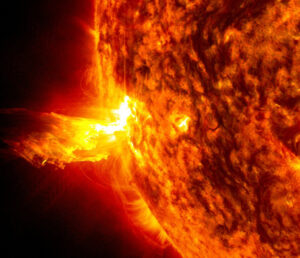
The bright light of a solar flare can send a coronal mass ejection into space, a solar phenomenon that can send billions of tons of particles into space that can reach Earth one to three days later. These particles cannot travel through the atmosphere to harm humans on Earth, but they can affect electronic systems in satellites and on the ground. Credit: NASA
- Multi-constellation (three or more) GNSS, implemented at both the base (or RTN) and rover, rode out the storms far better than single-dual constellation gear. The former, especially newer gear with the solar activity measures manufacturers have recently added, typically continued to operate just fine. Users may have experienced slightly slower fixes, but residuals were mostly acceptable.
- Older rovers struggled, or were not useable, though most of this may be due to being limited to single or dual constellations.
- Rover quality matters. Low-tier and DIY rovers (and boards in some drones), that otherwise might perform adequately for many types of work, did not fare well. For the same reason such units often struggle under canopy or in the vicinity of multipath hazards, solar storms (albeit infrequent) hit them hard.
- Post-processing does not help. If the base (and rover) data for a period was affected by the solar storm, then no amount of post-processing will fix it.
There are, of course, certain exceptions. Scintillation is happening all the time, even during the Solar Minimum. It is typified by intense, local, and often brief periods of elevated space weather conditions. During solar storms, the effects of scintillation can be exacerbated. So, even top-performing rovers that were otherwise riding out the storm just fine, may have experienced brief periods of intense effects. And some users also experienced cellular connectivity and radio issues.
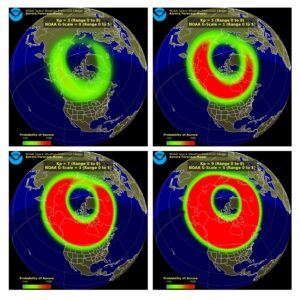
When the Aurora Borealis is visible in latitudes where you would not normally see it, this is a harbinger of heightened solar activity. The examples from the NOAA Space Weather Prediction Center indicate expected KP Index levels.
Heed the Warnings
You probably see frequent, seemingly daily, news bits about “the biggest solar storm ever.” Or you may have subscribed to an email list for solar warnings. The problem is that the sometimes-confusing terminology and various index conventions these sources present do not provide a GNSS rover user with a scale they can relate to exactly what to expect in the field.
While there is an index developed specifically for GNSS, the I-95 ionospheric index, and it is not a predictive resource, it can still be very useful for users to better correlate with the scales presented by the predictive resources. More on I-95 later.
The other challenge of space weather resources and predictions is that these are expressed mostly in terms of global levels, and may or may not reflect what is happening, or could happen in your specific vicinity. For instance, how does a global G2 storm warning equate to a Kp index level for North America?
Fortunately, for different regions of the world, prediction resources are more locally focused. In North America for instance, the National Oceanic and Atmospheric Administration (NOAA) provides a three-day predictive tool that is expressed in the Kp scale. Check this index daily at www.swpc.noaa.gov. Don’t send your crew out to survey on the other side of the state on what is predicted to be a 7+ Kp day (without their total station as a backup).
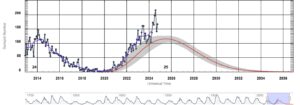
Figure 1: Progression of Solar Cycle 25 (upper). Sunspot counts are a key indicator of increased solar activity. Note the contrast to previous cycles (lower). Source: NOAA
You might see a G-level solar storm warning, and/or Kp index prediction, but keep in mind, that those are often issued on a global level; effects could be very different in the geomagnetic equatorial region and the far north of North America, etc.
Here is where the I95 index could be very handy. I95 is calculated by many local, state, or regional real-time networks (RTN) using data from their own fixed stations. I-95 is often expressed in units of expected (if uncorrected) error (centimeters) and/or color-coded levels.
During rough solar days, users can begin to develop rules of thumb for their gear, by looking at observed Kp levels and locally observed I-95 levels, as in Figure 1. Then you can correlate these with what your gear experienced at different levels. This can make forecast scales more useful in planning your fieldwork.
Updating and Upgrading
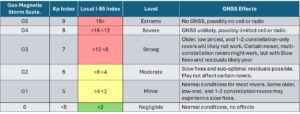
While it is difficult to predict just how much certain level events will affect your specific rover under your local conditions, there are several types of indexes noted in space weather notifications that can help you develop your own “rules-o-thumb” for various scenarios.
The article, “Preparing for the Effects of Solar Cycle 25 on GNSS Applications” on xyHt.com includes details about what GNSS rover manufacturers have done, since the last solar peak, to help mitigate the effects of solar storms. In some cases, the features were only practical on newer, multi-constellation rovers (with a lot of processing power). In some cases, a firmware update (for newer gear) activates it. But for older gear, there is no option for this.
Drone work can especially be challenging and frustrating during bad solar days. Many (even some of the most popular) drones have small, light, and relatively inexpensive GNSS boards. There are typically very popular, low-cost GNSS (and GNSS+IMU) boards developed for the nascent autonomy market, and quite appealing to mass-market drone manufacturers. Some firms have even taken the same boards and made rovers out of them (some via DIY kits). This is all great under optimal conditions, but perhaps it is not wise to try to use these during bad solar days.
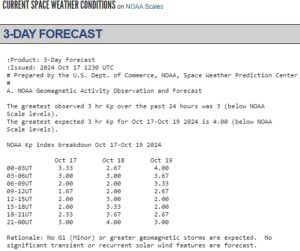
Example of a NOAA three-day forecast. In addition to Kp levels, solar storm G-scale notations will be added if G1 or above. NOAA has a 27-day prediction tool that can give you a rough idea, but it is best to check later with the three-day tool.
Intense and Inconvenient but Infrequent
In the first 10 months of 2024, we had recorded a dozen bad solar days. Fortunately, half of these fell on weekends (pure luck). The prospects of a no-go day about once a month might not impact the operations of some uses, but it can be a serious proposition for others.
And please, don’t fall into the “vibe-ospheric” trap. Yes, we are at the peak of a solar cycle, and it casts bad vibes over field operations, but you should not blame everything on it. You might be having comms issues, settings issues, multipath, or another issue you should troubleshoot. Instead, some users blame it all on the sun.
Planning ahead for field operations is not new. After all, you can’t do star shots or sun shots on cloudy days. NASA can launch a rocket to the moon, but not on a rainy day. Plan ahead.

